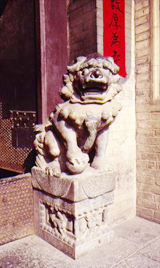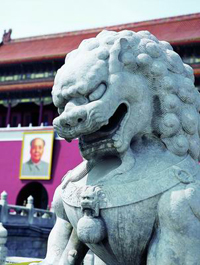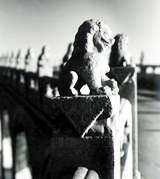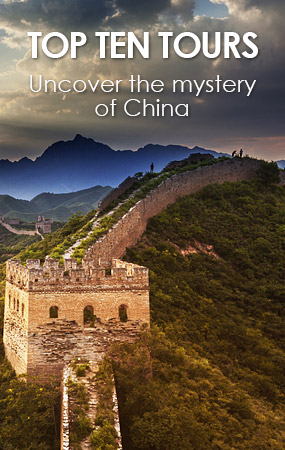Chinese Stone Lions
 Lion is a special animal to Chinese people. A pair of stone lions, a male and a female, can often be seen in front of the gates of traditional buildings. The male lion is on the left with his right paw resting on a ball, and the female on the right with her left paw fondling a cub.
Lion is a special animal to Chinese people. A pair of stone lions, a male and a female, can often be seen in front of the gates of traditional buildings. The male lion is on the left with his right paw resting on a ball, and the female on the right with her left paw fondling a cub.
The lion was regarded as the king in the animal world so its imagines represented power and prestige. The ball played by the male lion symbolized the unity of the empire, and the cub with the female thriving offspring.
The stone lions were also used to indicate the ranks of officials by the number of lumps representing the curly hair on the head of the lion. The houses of first grade officials had lions with 13 lumps and the number of lumps decreased by one as the rank of the official went down each grade. Officials below the seventh grade were not allowed to have stone lions in front of their houses.
 It is interesting to note that China had no lions originally. It is believed that when Emperor Zhang of the Eastern Han reigned in AD 87, the King of Parthia presented a lion to him. Another lion was given by a Central Asian country known as Yuezhi in the next year. The earliest stone lions were sculpted at the beginning of the Eastern Han Dynasty (25 - 220 AD) with the introduction of Buddhism into ancient China. It is said, Sakyamuni, the founder of Buddhism, was seen after birth "to point to Heaven with one hand and to Earth with another, roaring like an lion." In the Buddhist faith, the lion is considered a divine animal of nobleness and dignity, which can protect the Truth and keep off evils.
It is interesting to note that China had no lions originally. It is believed that when Emperor Zhang of the Eastern Han reigned in AD 87, the King of Parthia presented a lion to him. Another lion was given by a Central Asian country known as Yuezhi in the next year. The earliest stone lions were sculpted at the beginning of the Eastern Han Dynasty (25 - 220 AD) with the introduction of Buddhism into ancient China. It is said, Sakyamuni, the founder of Buddhism, was seen after birth "to point to Heaven with one hand and to Earth with another, roaring like an lion." In the Buddhist faith, the lion is considered a divine animal of nobleness and dignity, which can protect the Truth and keep off evils.
 It was also popular to decorate bridges with sculpted-stone lions for the same reason. The best known of this is the Lugouqiao (also as MarcoPoloBridge), built from 1189 to 1192. The stone lions on the posts of the bridge are most famous. It is said there are 485 lions in all, but there may be 498 or 501. A famous proverb says "the lions on the Lugouqiao are uncountable."
It was also popular to decorate bridges with sculpted-stone lions for the same reason. The best known of this is the Lugouqiao (also as MarcoPoloBridge), built from 1189 to 1192. The stone lions on the posts of the bridge are most famous. It is said there are 485 lions in all, but there may be 498 or 501. A famous proverb says "the lions on the Lugouqiao are uncountable."

